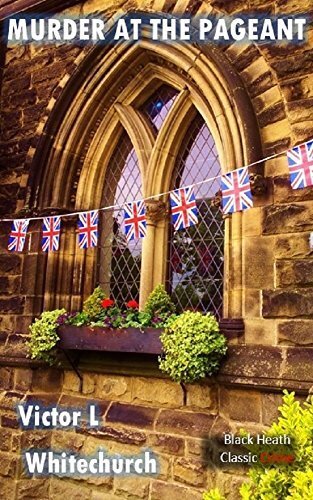Murder At The Pageant

A review of Murder at the Pageant by Victor Whitechurch – 250314
What with William Fone in Ianthe Jerrold’s Let Him Lie and now Victor Whitechurch’s 1930 novel set in Frimley, detective fiction seems to be getting personal. Whitechurch’s Frimley, though, seems to have little resemblance to the village where I live. The Manor, home to Sir Henry Lynwood, is hosting a pageant, the centrepiece of which is the parading for the first time in over a century of a sedan chair once used by Queen Anne, which is conveying Mrs Cresswell, resplendent in the costume of the queen and wearing her magnificent pearl necklace. All the guests wear period costume, a fact that will be telling in the denouement.
The director of the pageant is a former member of the Secret Service, Captain Roger Bristow. Late at night, after a post-pageant meal, he looks out of the window and sees two figures, he believes they are male, carrying off the sedan chair which had been stored in a marquee. He rushes down to see what is going on but they make good their escape in a car, although Bristow is alert to take the registration number. The ne’er-do-wells appear to stop temporarily at the estate gates before driving off.
Inside the sedan chair Bristow finds one of his fellow guests, Jasper Hurst, who has recently moved into a nearby house as Lynwood’s tenant, close to death and before he dies he mutters something that sounds like “the…line”. The getaway car bears the same registration number as the vicar’s and one of the house guests had just been to the marquee to recover his cigarettes but claims not to have seen anything. And just for good measure Mrs Cresswell’s jewels are discovered to have been stolen.
Having set the plot up Whitechurch has good fun in confounding his readers with red herring after red herring and misdirection after misdirection. We have a Chief Constable who claims he is nothing of a police officer but whose observations and conclusions are shrewd and to the point and the inevitable battle for the truth between the professional officer of the law, in this case Superintendent Kinch, and the gifted amateur, Bristow. They are not exactly rivals but Bristow is more astute and prefers to play his cards close to his chest while being perfectly open in divulging information when asked a direct question. Inevitably, it is Bristow who gets on to the truth of what happened at Frimley Manor.
One criticism of the denouement is that Whitechurch seems to pull three rabbits out of a hat by introducing characters late on that who had an enormous bearing on the outcome. That is true, although in fairness to Whitechurch he does sprinkle enough clues in the earlier chapters. We are told that Hurst was a private detective who specialized in the recovery of jewelry, that he had suspicions that his estranged wife had not given up her previous criminal associations, that Miss Fullinger’s maid has only recently been hired, that the car stopping at the gates is suggestive of someone from the house being involved, that someone at the pageant had recognized someone but the recognition had not been reciprocated, and that the putting away of costumes was germane to the case.
As for the motive for the final dramatic scene that did seem to me to come out of leftfield. I enjoyed the twist at the end in which the Chief Constable cracked the meaning of Hurst’s dying words and the fact that Mrs Cresswell’s jewels were not all they were cracked up to be. Clever Mr Cresswell.
Not a classic by any means but great fun.



